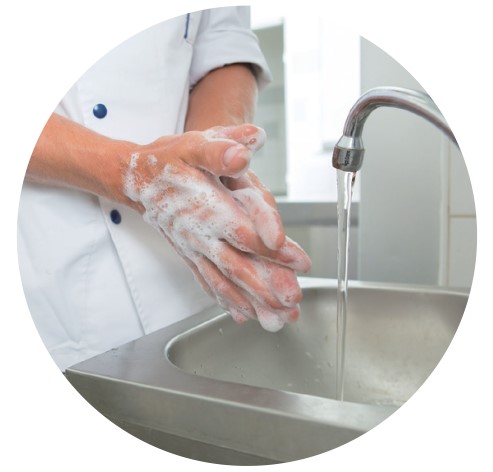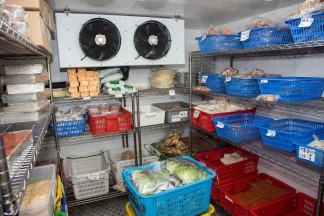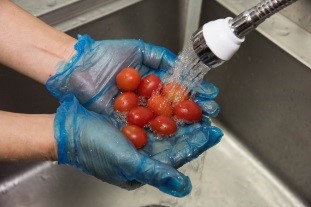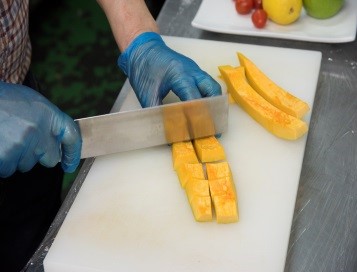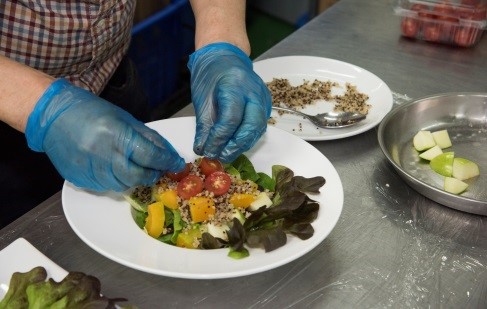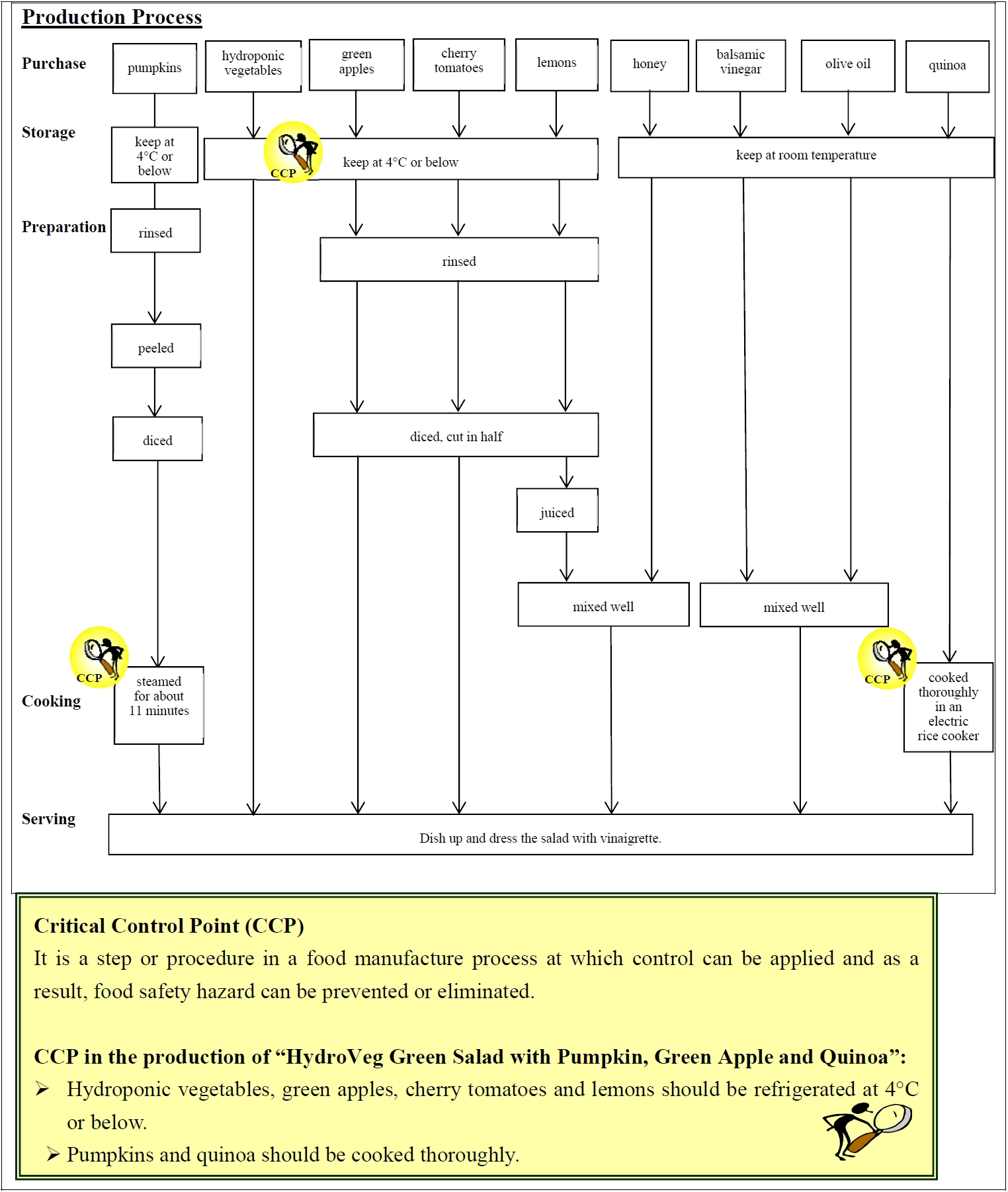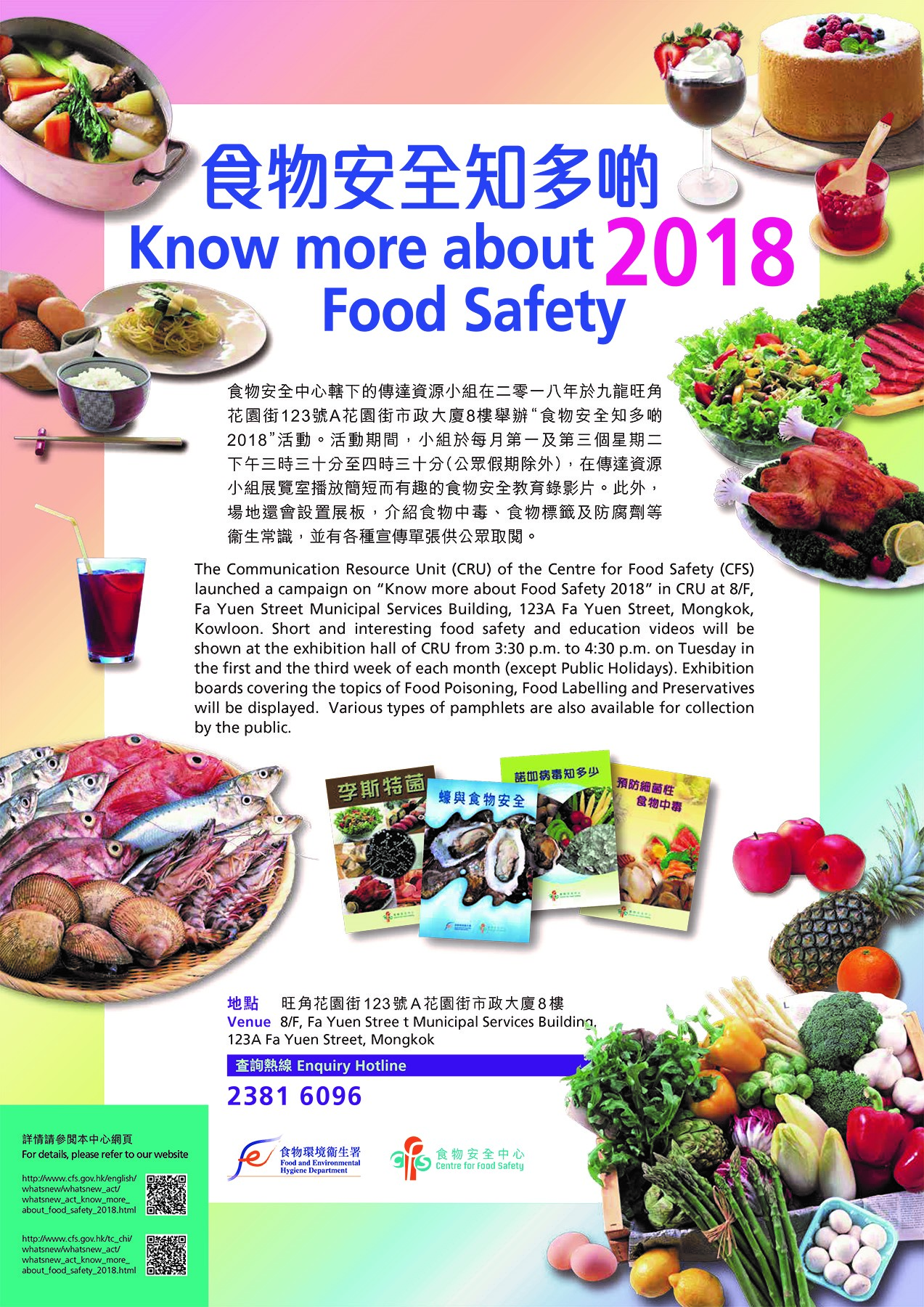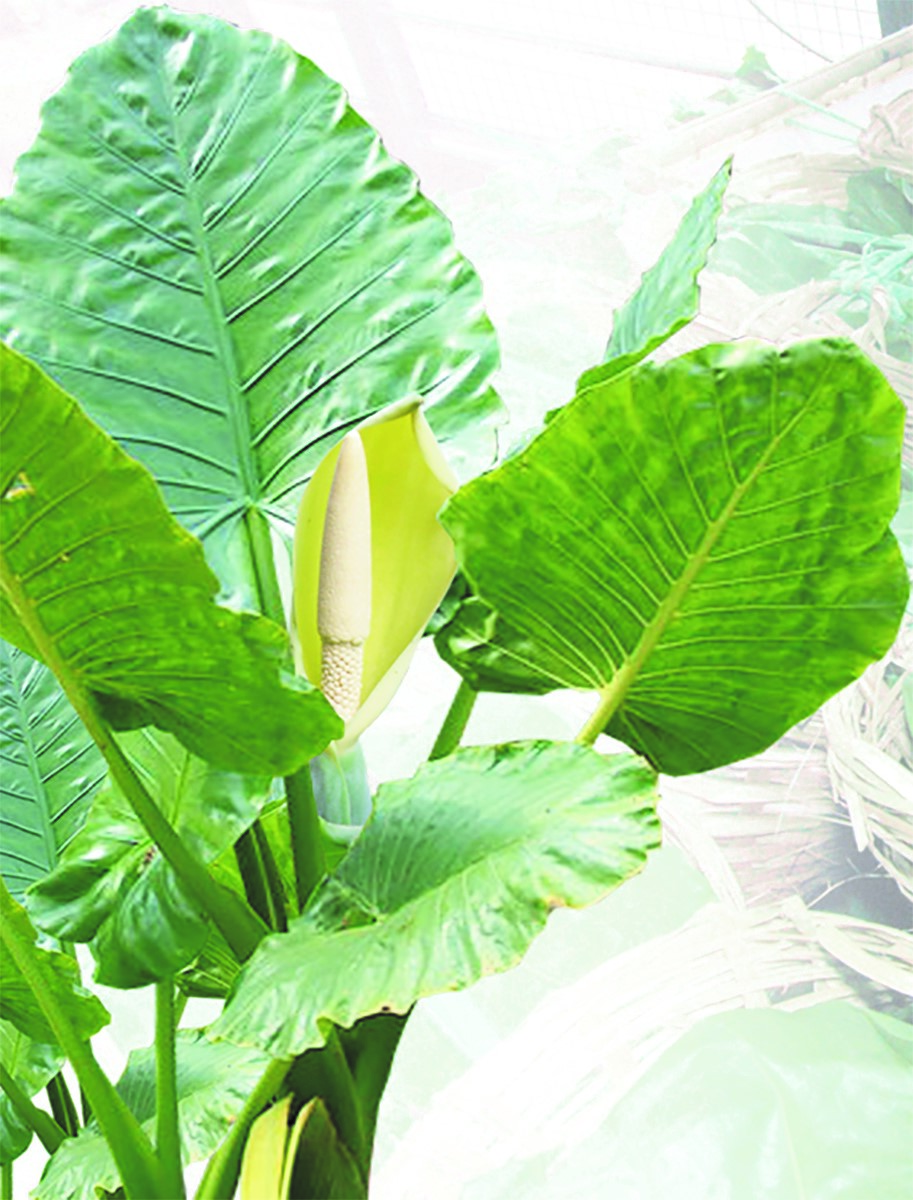
Feature Article
Sale and Safe Handling of Chilled Poultry
Chicken is probably the most widely consumed meat other than pork and beef. In fact, chicken is almost an indispensable menu item for celebration of joyous occasions. However, as a result of the government policy to control avian influenza, the number of shops and stalls selling live poultry has significantly dropped. In fact, more people begin to prepare food with chilled rather than fresh poultry meat. In this issue, we will discuss the requirements for sale of chilled poultry and the food safety tips on handling this kind of meat.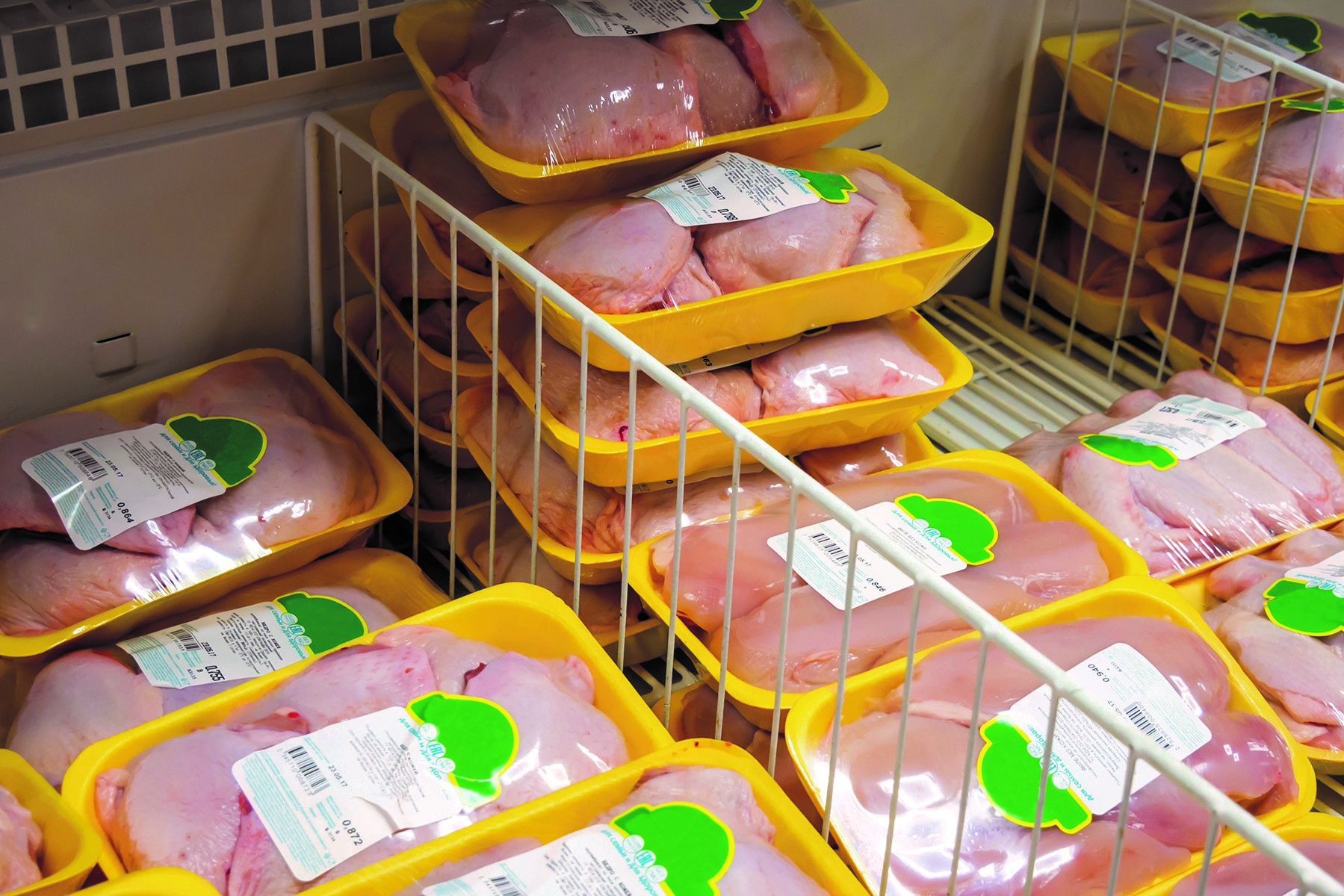
General Requirements for Sale of Chilled Poultry
Chilled poultry imported into Hong Kong mainly includes chickens, ducks, geese and pigeons. These meat products are confined to sources recognised by the Director of Food and Environmental Hygiene and must be accompanied by a certificate issued by the competent authority of the exporting country certifying that they are safe for human consumption. Shops and stalls selling chilled poultry must have refrigerators with sufficient capacity and appropriate temperature control (between 0ºC and 4ºC) for storage and display of chilled poultry. Notices complying with the required format should be prominently displayed, indicating that the sale of such commodities is available at the premises. Moreover, the persons-in-charge of the shops/stalls should keep invoices showing the sources of food supply for at least 60 days for inspection purposes.
Imported chilled poultry should be prepacked, labelled in accordance with the Food and Drugs (Composition and Labelling) Regulations (Cap. 132W) and sold directly from refrigerators to customers in the original and intact prepacked form. It is important not to overload the refrigerator. For good air circulation in the refrigerator, chilled commodities should be properly placed so that cold air outlets would not be obstructed.
The refrigerators/display chillers storing chilled poultry must be cleaned and sanitized regularly and thoroughly. After handling chilled poultry, workers should avoid wiping their eyes or mouths, and should immediately wash hands with soap and water.
Safe Handling of Chilled Poultry
Direct contact with infected poultry, or surfaces and objects contaminated by their faeces, is presently considered the main route of transmission of avian influenza. People in close contact with infected poultry, such as families with backyard flocks and poultry workers in wet markets or live animal markets, are therefore more susceptible to avian influenza.
The highly pathogenic avian influenza virus can be found in many parts of an infected bird. The virus does not multiply in poultry carcasses but can survive several days at ambient temperatures and up to 23 days if refrigerated. Freezing and refrigeration are not effective in reducing the concentration or virulence of the virus on contaminated meat. However, normal cooking (temperatures at or above 70°C) will inactivate the virus. The World Health Organization (WHO) holds the view that to date there is no epidemiological information to suggest that avian influenza can be transmitted through properly cooked food (even if contaminated with the virus prior to cooking).
As a general precautionary measure, the public and the trade are advised to observe good personal, food and environmental hygiene. The following good hygienic practices are of particular importance in avoiding the spread of the virus through food.
Advice to the Public
Readers' Corner
1. Reduction of Sodium (Salt)/Sugar in Prepackaged Foods
The amount of nutrients we absorb from food is closely related to our health. Excessive intakes of sodium can increase the risk of hypertension, stroke and coronary heart disease, and free sugars (monosaccharides and disaccharides) from dietary sources can heighten the risk of dental caries. Excess calories from foods and beverages high in free sugars also contribute to unhealthy weight gain, which in turn leads to obesity, diabetes and other non-communicable diseases.
Taking food safety, food quality and consumer acceptance into consideration, product reformulation is the widely adopted approach to reduce the intake of salt/sugar from prepackaged foods.
Salt Reduction in Prepackaged Foods by Product Reformulation
The process of setting targets for sodium reduction in foods is complex since the role and function of salt vary depending on the nature of the food. Nevertheless, many countries (e.g. the United States, the United Kingdom and Canada) have established sodium reduction targets in various food categories to promote product reformulation to the food industry.
Manufacturers of prepackaged foods can gradually reduce the amount of salt used, source low-sodium ingredients or replace sodium with alternatives to lower the sodium levels in prepackaged foods. For instance, some natural ingredients (e.g. lemon, tomato), herbs and spices (e.g. chilli) can be used for flavouring. To help customers avoid excessive intakes of salt, the trade can offer different portion sizes of prepackaged foods for customers to choose. If smaller portion sizes are not possible, the package can be improved (e.g. use of zipper bags or resealable boxes) for proper storage of the remaining food so that consumers need not finish the food within a short time and are able to avoid overconsumption of salt.
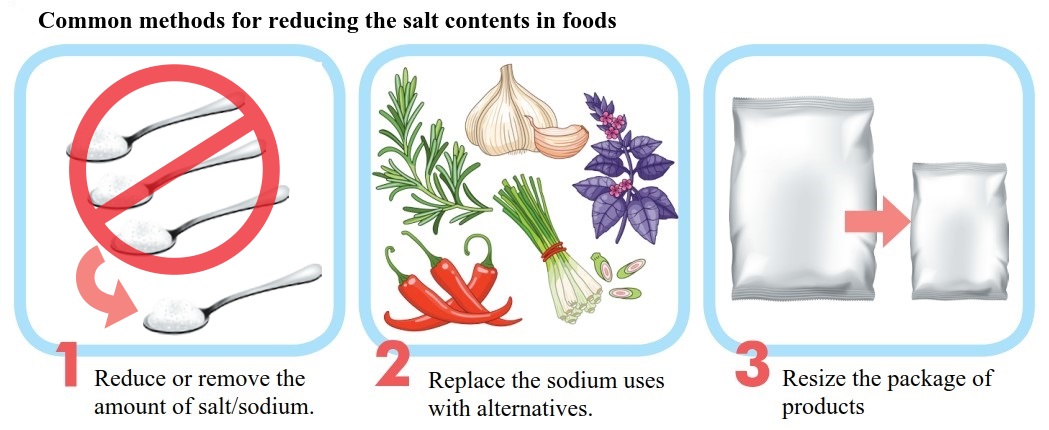
Product reformulation has been proved practical in overseas countries. In Ireland, there was a substantial reduction of sodium content in sausages (11%) and various breakfast cereals products (38% to 63%) from 2003 to 2015. In the United Kingdom (UK), the sodium content of a ketchup product was reduced by 39% from 2000 to 2012. Locally, prepackaged foods with reduced sodium contents (e.g. low-sodium soy sauce and luncheon meat) are available on the market.
Free Sugars Reduction in Prepackaged Foods by Product Reformulation
Free sugars, besides being naturally present in honey, syrups, fruit juices and fruit juice concentrates, are often added to prepackaged foods and beverage products. Non-alcoholic beverages including prepackaged teas, carbonated drinks, fruit and vegetable juices/juice drinks are significant total sugar intake contributors in Hong Kong. Carbonated drinks and juice drinks are targets for product reformulation in many places. In some countries, such as the UK, a maximum level of sugar in prepackaged beverage products is set as the target level for reformulation.
To reduce the health problems arising from excessive intakes of free sugars at the population level, some countries have established sugar reduction targets, while others have introduced taxation on sugary products, with a view to engaging the trade in reformulating and resizing their products and encouraging the public to reduce buying and consuming these products. For example, the UK government has set a target to reduce the sugar content across a range of products that contribute most to children’s sugar intakes by at least 20% by 2020 as compared with the 2015 base-line levels. In some countries (e.g. France, Mexico), taxation is in place for the sugary drink/soft drink industry, while others (e.g. the UK in April 2018) have plans to introduce a sugar levy.
Reduction of sugar in prepackaged foods and beverages can be achieved by sourcing ingredients with lower sugar contents, adding less free sugars to the products or using sugar substitutes. Some examples of product reformulation include putting in fruits to reduce the amount of added sugar in yoghurts, providing no-sugar added products for breakfast cereals, and replacing sugar in biscuits with fibres.
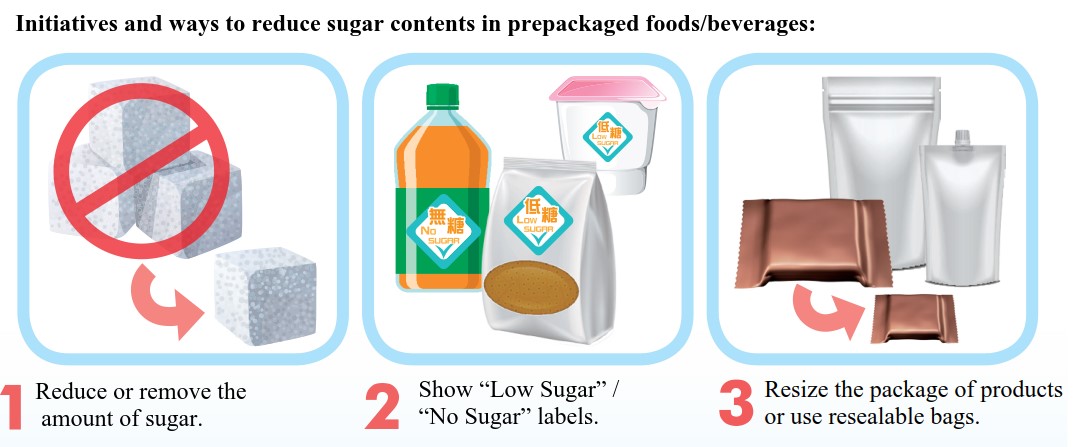
“Salt/Sugar” Label Scheme for Prepackaged Food Products
In Hong Kong, the Committee on Reduction of Salt and Sugar in Food (CRSS) and the Government jointly introduced the voluntary “Salt/Sugar” Label Scheme for Prepackaged Food Products (the Scheme) in October 2017 to assist consumers in identifying low-salt and low-sugar products. Trade members can display the relevant labels on their prepackaged foods and beverages which meet the conditions for the claims “low sugar”/ “low sodium”/ “no sugar” / “no sodium” under the Food and Drugs (Composition and Labelling) Regulations (Cap. 132W). The scheme would enable consumers to choose food products with less salt and sugar.
Trade Support and Participation
Reformulation to reduce free sugars/salt in the products, cutting the portion size and using package labelling to facilitate consumers in selecting products low in salt/sugar are useful ways to achieve better public health through reduced salt/sugar intake. Reduction of salt and sugar in prepackaged foods can be successfully achieved through joint efforts of the Government, the trade and consumers. Trade members should strive to reformulate their recipes to provide the public with more quality foods that contain less salt and sugar by making reference to the Trade Guidelines for Reducing Sodium in Foods and the Trade Guidelines for Reducing Sugars and Fats in Foods developed by the Centre for Food Safety (CFS).
2. Siu Mei and Lo Mei Are High-risk Foods
In late 2017, a few clusters of consumers developed abdominal pain, vomiting and diarrhoea after having meals containing lo mei dishes in a restaurant. In Hong Kong, lo mei is a restricted food, the manufacturing and sale of which is subject to licensing control under Schedule 2 of the Food Business Regulation (Cap. 132X).
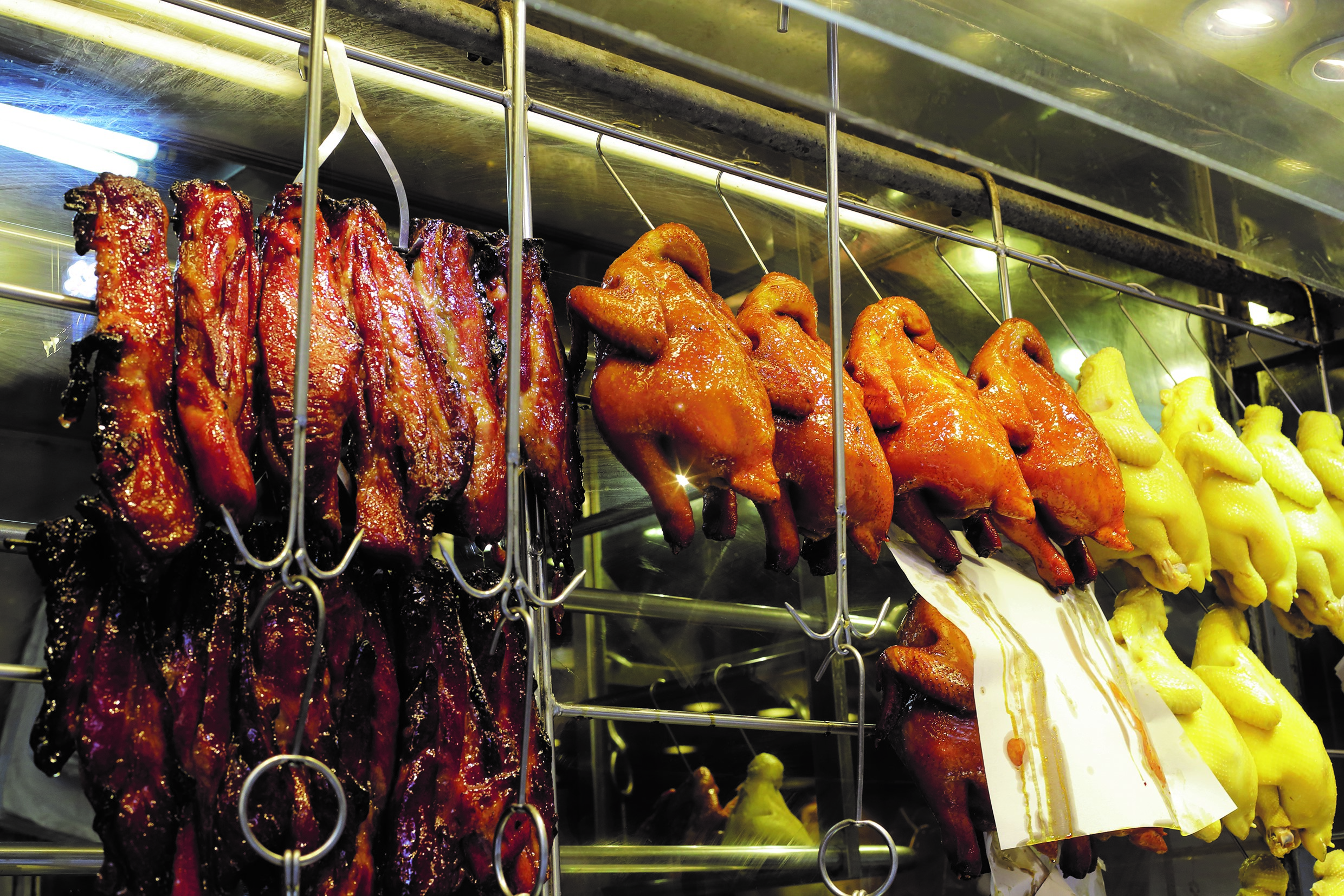
Siu Mei and lo mei are high-risk foods, as they are ready-to-eat items seldom reheated after initial heat treatment prior to serving. The common practices of restaurants to leave siu mei and lo mei at room temperatures (within the danger zone of 4°C-60°C) for long periods and handle these foods with bare hands also fuel the risk of microbiological contamination. Consumers are advised to patronise licensed food premises with good hygiene conditions and consume siu mei and lo mei as soon as possible after purchase. Any leftovers should be refrigerated at 4°C or below and reheated thoroughly before consumption.
News on New Dishes
HydroVeg Green Salad with Pumpkin, Green Apple and Quinoa
Salad is not only healthy but also tasty. In this issue, we bring you the HydroVeg Green Salad with Pumpkin, Green Apple and Quinoa. Mr Jack SO, Executive Chef of Grove Sandwiches (a signatory of the Food Safety Charter), will show us how this simple and refreshing salad is prepared. Give it a try!
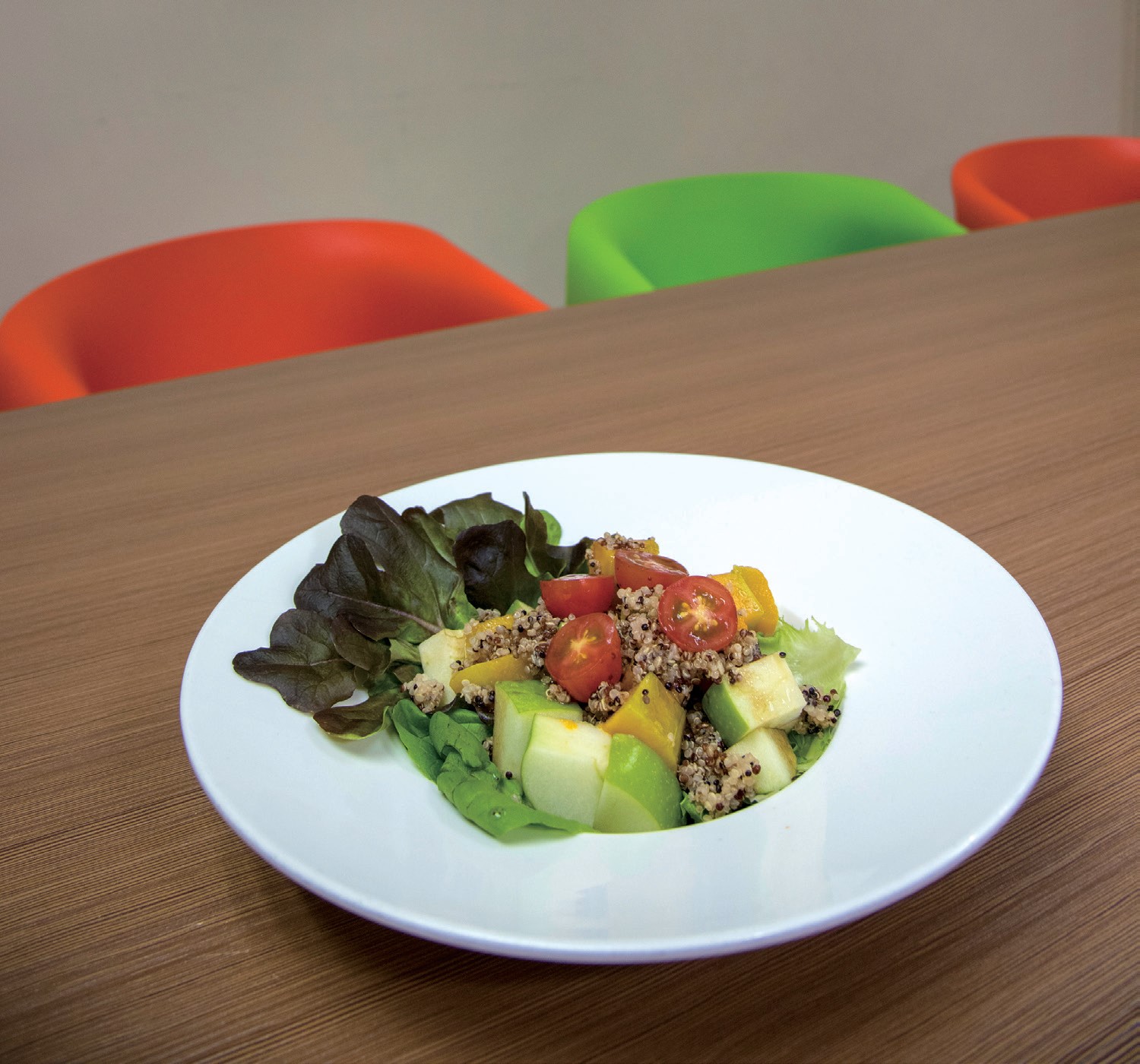
| Preparation Steps | Small Tips, Big Wisdom | |
|---|---|---|
|
Receiving
|
Purchase the ingredients such as quinoa, green apples, pumpkins, hydroponic vegetables, cherry tomatoes, balsamic vinegar, olive oil, lemons and honey from approved and reliable suppliers. | Upon receipt of the ingredients, check carefully to ensure their freshness and that the shelf life requirements are met. Green apples, pumpkins, hydroponic vegetables, cherry tomatoes and lemons should be refrigerated at 4°C or below. Place the quinoa and other dressings on shelves in an orderly manner. Foods should be consumed within their shelf life. Stick to the “first-in-first-out” principle and use the earliest stocks with the shortest shelf life first. |
|
Rinsing & Cutting
|
Rinse the green apples, pumpkins, cherry tomatoes and lemons thoroughly. Cut the cherry tomatoes and lemons in half, juice the lemons and dice the green apples for later use. Choose hydroponic vegetables which have been thoroughly washed by suppliers. |
Rinsing the ingredients thoroughly under clean running water can effectively reduce the risk of pesticide intake. Scrub produces with hard surfaces with a clean brush to remove dirt and substances including pesticides and contaminants from the surface and crevices. Wearing disposable gloves in food preparation is a convenient way to ensure food hygiene. |
|
Steaming and Cooking
|
Peel the pumpkins and dice into cubes of about 2.5cm. Steam for around 11 minutes. Set aside. Rinse the quinoa thoroughly and put it into the rice cooker. Add 1.5 parts of water and cook until done. |
Chopping ingredients into fine pieces helps shorten the cooking time. |
|
Mixing
|
Mix about 6 parts balsamic vinegar with 1 part olive oil. Add fresh lemon juice to honey. Mix well and set aside. |
The use of seasonings can be reduced by using natural ingredients. |
|
Preparing
|
Place the hydroponic vegetables, diced green apples and pumpkins, quinoa and cherry tomatoes on a plate. Add in balsamic vinegar, olive oil, as well as honey mixed with lemon juice. Ready to serve. |
Consume as soon as possible. Salads kept at ambient temperature for more than 4 hours should be discarded. |
Chef's Tips:
Food Safety Plan Corner
HydroVeg Green Salad with Pumpkin, Green Apple and Quinoa
Ingredients:
Quinoa, green apples, pumpkins, hydroponic vegetables, cherry tomatoes, balsamic vinegar, olive oil, honey, lemons
Steps:
- Take out the green apples, pumpkins, cherry tomatoes and lemons that are refrigerated at 4ºC or below. Rinse them thoroughly.
- Cut the cherry tomatoes and lemons in half, juice the lemons and dice the green apples for later use.
- Peel the pumpkins and dice into about 2.5cm cubes. Steam for around 11 minutes. Set aside.
- Take out some quinoa, balsamic vinegar, olive oil and honey from the dry goods shelves. Rinse the quinoa thoroughly and put it into the rice cooker. Add 1.5 parts of water and cook until done.
- Mix about 6 parts balsamic vinegar with 1 part olive oil. Add fresh lemon juice to honey. Mix well and set aside.
- Take out some hydroponic vegetables that are refrigerated at 4ºC or below (choose hydroponic vegetables which are thoroughly washed by suppliers) and place them with diced green apples and pumpkins, quinoa and cherry tomatoes on a plate. Add the dressing of balsamic vinegar, olive oil, as well as honey mixed with lemon juice. Ready to serve.
Briefing of Activities
Dedicated Instagram Page on Hong Kong's Action on Salt and Sugars Reduction

Further to the launching of the dedicated Facebook page on Hong Kong’s Action on Salt and Sugars Reduction (https://www.facebook.com/HongKongsActiononSaltandSugarsReduction) in 2015, the CFS created a dedicated Instagram page on Hong Kong’s Action on Salt and Sugars Reduction (https://www.instagram.com/hkassr) in July this year to enhance promotion of healthy eating with less salt and sugars among the public and the trade.
Salt and sugars are closely related to our health. Excessive dietary salt intake increases the risk of hypertension, stroke and coronary heart diseases, while excessive intake of sugars in food leads to obesity and dental caries.
In recent years, the Government has devised and implemented a strategic plan to promote the reduction of intake of salt and sugars in food in order to promote a healthy diet. The Government’s target is to gradually reduce the intake of salt and sugars by Hong Kong people to the levels recommended by the WHO. For salt reduction, the WHO recommends its members to reduce the mean population intake of salt by 30% by 2025. It further recommends that adults should consume less than 5g of salt per day. As regards sugar reduction, the WHO recommends that the intake of free sugars should be less than 50g (i.e. 10 sugar cubes) per day for an individual with a daily energy intake of 2 000 kilocalories. According to the WHO and the Food and Agriculture Organization of the United Nations (FAO), free sugars mean all sugars added to foods by manufacturers, cooks or consumers, plus sugars naturally present in honey, syrups and fruit juices.
To align with the Government’s target, the CFS has actively promoted salt and sugar reduction through different platforms including the dedicated Facebook and Instagram pages. It has endeavoured to reduce the salt and sugar contents in food in Hong Kong through public education, sharing of expert advice and display of successful international experience, so as to assist the public to practise and develop healthy dietary habits.
A wide range of information on dietary salt and sugar reduction, including health risks caused by excessive intake of salt and sugars and related risk assessments and studies, as well as practical tips on how to reduce the intake of salt and sugars in daily diet, is available on the above dedicated Facebook and Instagram pages.
The CFS will continue to mobilise the participation of different sectors of society (including the trade and consumers) to further promote the reduction of dietary salt and sugars in Hong Kong.
Upcoming Activities
Know more about Food Safety 2018
Food Safety Q&A
Is Giant Alocasia edible?
Truth against Fallacy
Are Powdered Infant Formulas (PIFs) Sterile?
Background
In December 2017, the consumption of PIFs was implicated as the vehicle of Salmonella outbreak among infants in France and the implicated products from the concerned company had to be recalled. As such products are available for sale in Hong Kong, the CFS instructed traders to stop sale and remove from shelves the affected batches of products.
Pathogens of Concern in PIFs
Years ago, the FAO/WHO expert meetings evaluated specific microoganisms in PIFs that resulted in cases of illness in infants, which concluded that PIFs contaminated with Cronobacter species (formerly Enterobacter sakazakii) and Salmonella have been convincingly shown to be the vehicle and source of infection in infants. In fact, both Cronobacter species and Salmonella are able to survive in dry environments (like dried food and food processing environment) for a prolonged period of time. Moreover, low-level intrinsic contamination in PIFs by these microorganisms has been confirmed in some previous outbreaks.
PIFs Are Not Sterile
Generally, PIFs are manufactured according to three process types: a wet-mix process, a dry-mix process, and a combined process (see illustration). Some people may expect PIFs to be sterile products, yet current technology does not achieve the production of sterile PIFs.
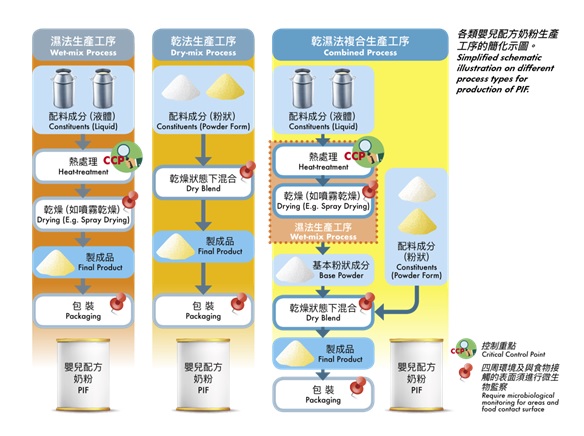
Unlike liquid milk which can be sterilised by heat-treatment in-container (i.e. sterilised milk) or by heat-treatment in a continuous flow system followed by aseptic filling in a sterilised container (i.e. ultra-high temperature treatment milk), PIFs have to be produced in dried form. Drying or dry blending under non-sterile condition is involved and heat-sensitive ingredients may be added. Worse still, it is difficult to completely inactivate microbial pathogens in the final product as bacterial cells under dry condition usually exhibit increased heat resistance.
Recommendations on Reconstituting PIFs
Although PIFs are not sterile products and can also be contaminated after opening, proper reconstitution prior to feeding could decrease the risk posed by microbiological hazards. The FAO/WHO advises that PIF should be prepared with boiled water no cooler than 70°C, which can significantly inactivate pathogens including Salmonella. Reconstituted PIFs should then be cooled to feeding temperature and consumed immediately. Reconstituted PIFs that have not been consumed within two hours should be discarded. For high-risk infants (including infants less than two months of age, pre-term infants, low-birth-weight infants (<2.5kg), and immunocompromised infants) who are not breastfed, caregivers should use commercially sterile liquid formulas whenever possible.

Advice to Caregivers
- Thoroughly clean and sterilise all equipment used for feeding infants and for preparing feeds.
- PIFs should be prepared with boiled water no cooler than 70°C, which can significantly inactivate pathogens including Salmonella. Reconstituted PIFs should then be cooled to feeding temperature and consumed immediately. Reconstituted PIFs that have not been consumed within two hours should be discarded.
- Beware of the hygienic and safe practices for preparing PIFs which are also recommended in prevailing guidelines issued by the FAO/WHO.
Brain Gym
Matching (Linking)
Natural toxins in food
Answer: (a) --- (iii)
(b) --- (i)
(c) --- (ii)
(d) --- (iv)
Enquiries and Subscription
Printed copies of the Food Safety Bulletin can be obtained from the Communication Resource Unit at 8/F, Fa Yuen Street Municipal Services Building, 123A Fa Yuen Street, Mong Kok, Kowloon. For enquiries, please call 2381 6096. The public may also visit the CFS website (www.cfs.gov.hk) for the online version.
